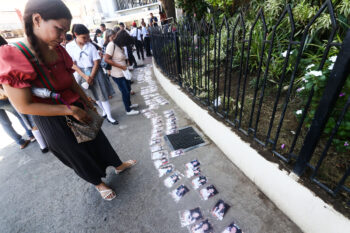DAVAO CITY (MindaNews/10 May) – The Lumad communities have express alarm over the consecutive killing of three tribal leaders in Monkayo, Compostela Valley these past few years.
The latest killing was of Bae Floreta Caya from the Mandaya tribe last April 27. Caya succeeded Manguangan Datu Carlito Chavez when he was slain last year. Chavez was also a successor of Mandaya Datu Liling Andresan, who was killed in April 2009.
All three leaders were slain by still unidentified motorcycle-riding gunmen.
According to Bae Norma Rivera, executive committee member of the Mindanao Indigenous People’s Conference for Peace and Development (MIPCPD), the three slain leaders were all managers of the town’s Ancestral Domain Management Office (ADMO).
“These leaders were given authority by the Lumad communities to represent (them) and to implement the Ancestral Domain Sustainable Development Protection Plan (ADSDPP), the most important responsibility of a manager,” she said.
Rey Bahinting, legal assistant at the National Commission on Indigenous Peoples (NICP) in Southern Mindanao, said that over 500 tribal leaders have already been killed since the 1980s.
Datu George Mandahay, the Marilog tribal deputy mayor, said that at first, they thought the killings were just part of the dynamics among indigenous peoples. Thus, last April 20, they held a Limpas-Uli-Uliay-Sinapay, which is the highest form of ritual for conflict resolution, to unify all four tribes in the Monkayo area.
To their surprise, just one week after the Limpas, Bae Floreta Caya was shot in the head inside her own house. The suspect fled with a motorcycle, Mandahay said.
“We can’t regard this anymore as simply tribal dynamics, because killing women is against our culture. We regard the women as the symbol of peace; that is why they act as mediators in times of conflict. We believe that there are other groups who want to divide us for their self-vested interest,” he added.
Rivera said that as of this moment, they have no leads yet as to the perpetrators. “The only thing we know is that our land is rich in mineral resources, and many groups want to enter the whole area,” she said.
She added that the killings have instilled fear among tribal communities. “Thus, no one wants to stand as leader to assert our rights and maintain political will to lead the people,” Rivera stressed.
Mandahay said they are calling on everyone to respect their culture and their rights. “We are a peace-loving people and we don’t kill each other just for the sake of wealth,” he lamented.
The MIPCPD has taken the matter to the Commission on Human Rights to conduct impartial investigations.
In 2002, the ADSDPP was completed by the Lumad communities and was endorsed by the late Monkayo Mayor Joel Brillantes through Executive Order 32-2002. In July 2003, the National Commission on Indigenous Peoples awarded the Certificate of Ancestral Domain Title, which covers an area of 30,400 hectares, to the indigenous cultural communities of Mandaya, Manobo, Mangguangan, and Dibabawon tribes in Monkayo.
On June 17, 2009, the four tribes entered into an operating agreement with the Philippine Mining Development Corporation. This authorized the IPs to proceed with mining operation in designated tribal mining areas that cover a total of 950 hectares.
But explorations in the area by different investors without pertinent documents have caused misunderstanding among the IP communities; thus, the Lumads hold the Limpas to appease the conflict among tribes and strengthen the unity of the communities. (With reports)
